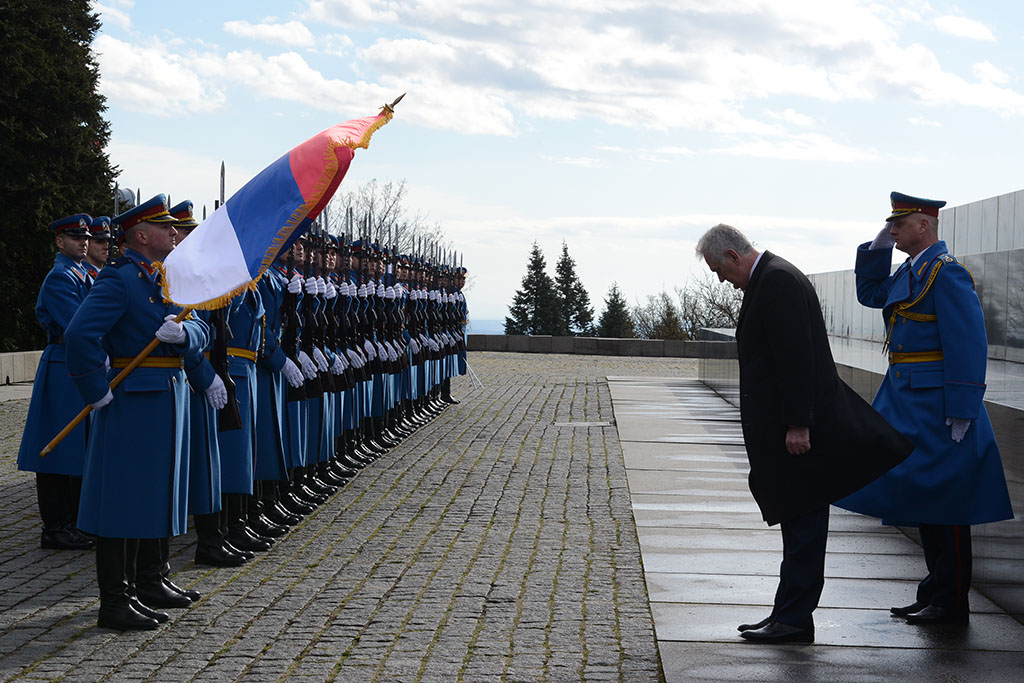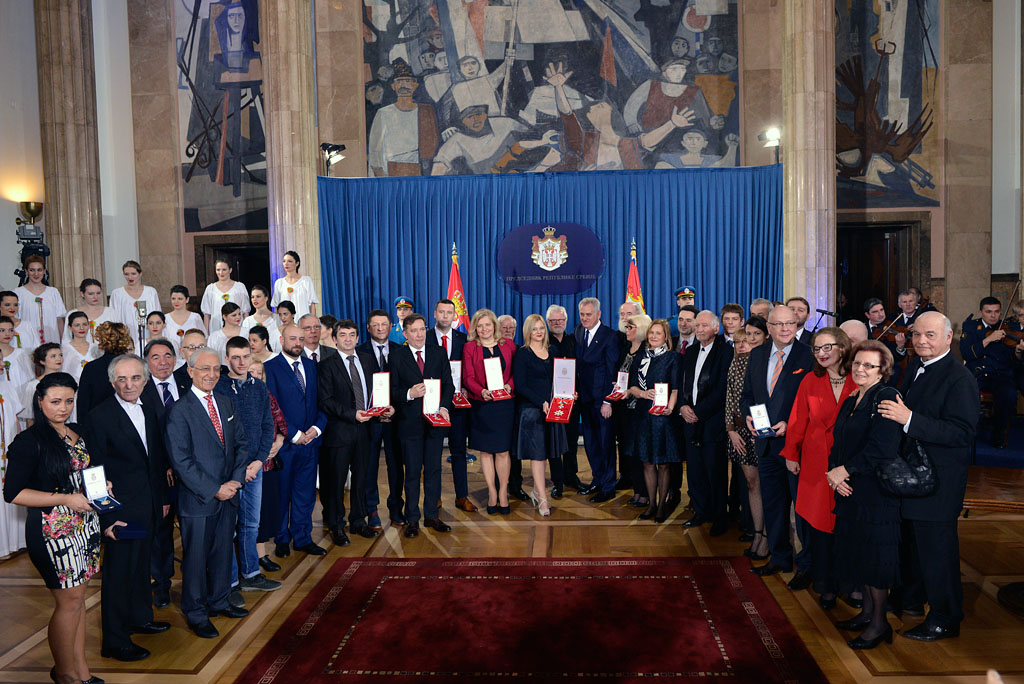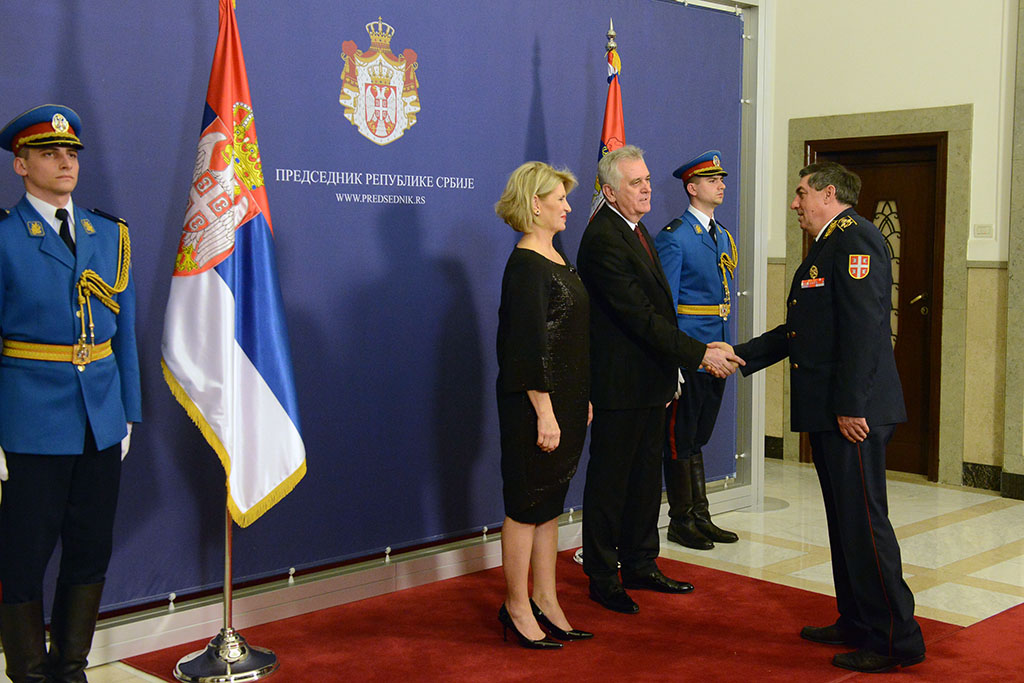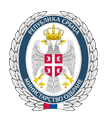- About MoD
Minister and Associates
- Minister
- State Secretary
- Assistant Ministers
- Secretary of the Ministry of Defence
Sectors
- Defence Policy Sector
- Human Resources Sector
- Material Resources Sector
- Budget and Finanance Sector
- Sector for Infrastructure and Hospitality Services
- SAF
- Documents
- Services
- Sport
- Archive
- Contacts
15.02.2016.
Marking the Statehood Day of the Republic of Serbia
 With a series of events, Serbia is marking today its Statehood Day, as a reminder of the day of Candlemas (Serbian Sretenje) in 1804, when the revolution was raised and the liberation from Turkey started, and the same date in 1835, when the first modern constitution of Serbia was adopted.
With a series of events, Serbia is marking today its Statehood Day, as a reminder of the day of Candlemas (Serbian Sretenje) in 1804, when the revolution was raised and the liberation from Turkey started, and the same date in 1835, when the first modern constitution of Serbia was adopted.On the occasion of the Statehood Day, Serbian President Tomislav Nikolic, accompanied by Chief of the Serbian Armed Forces General Staff General Ljubisa Dikovic, laid a wreath at the Monument to the Unknown Hero on Avala today.
President Nikolic wrote in the memorial book:
"On the day of Sretenje in 1804, Serbia opened the door to freedom, and on the day of Sretenje in 1835 the door of democracy. For the honour, glory and praise to our ancestors, as a lesson to us and our descendants. Eternal is Serbia."
On the occasion of the Statehood Day, Nikolic awarded decorations to deserving individuals and institutions, thanking them for their well-deserved awards.
"You have distinguished yourself, and the President only failed to award decorations to all those who have distinguished themselves. So until the end of my mandate I will have to continually put up with my own inability to present the decorations to everyone who rose above us and distinguished themselves", Nikolic said at the ceremony.
He underlined that the promotion of the social values such as the culture of praise, culture of reward, culture of thanksgiving should not be at the bottom, classified as less important.

"Inexplicable is indifference towards the success of individuals and institutions which are, in most cases, more known to the public abroad than in their own country", Nikolic said.
According to him, his and our duty and privilege in building the humane community is to "distinguish those who leaped out" building and promoting the highest values by their selfless efforts and renunciations.
"Then it is one of the jobs that brings me the most joy. Maybe (Ivo) Andric would say that this is how, in our time, we leave signs along the road to future generations", the President said. He added that, as much as our athletes bring national pride and joy, the same sentiments could be shared with the public when it comes to art or science, only if, he says, such results would be more visible or even at all visible in our media, discussions, everyday life beyond the narrow circles of experts and colleagues.
"Finally, one of the basic units of measure of the success of a state and society is also in the extent to which it contributes to the progress of not only its homeland, but civilization as well, and the fact how much its citizens are present in the world's scientific or artistic community, and how the world evaluates their achievements", Nikolic said.
The President of the Republic of Serbia awarded also 105 members of the Ministry of Defence and the Serbian Armed Forces who will be presented awards on the occasion of 23rd April – the Day of the Serbian Armed Forces.
On the day of Sretenje in 1804, at the Assembly of prominent Serbs from the territory of Belgrade (i.e Smederevo) pashaluk, which occurred in Maricevica ravine in Orasac, the decision was made about the uprising against the Turks and Djordje Petrovic – Karadjordje was elected as the Supreme Leader.
The decision on the uprising was preceded by the slaughter of the local dukes, the most prominent national nobles, who were preventively executed by the dahijas (janissary commanders) because of the alleged disloyalty. The First Serbian Uprising first included the regions west of Kolubara, Sumadija and Pomoravlje. The whole Belgrade pashaluk was liberated in 1807, but the fate of the uprising was determined by the outcome of the Russian-Turkish war, since Russia and Turkey signed peace in Bucharest in 1812.
Leaving Serbia was the result of the fact that Napoleon began the march on Russia. According to Ranke, Karadjordje’s uprising started the Serbian revolution, which was completed by successful diplomatic achievements of Milos Obrenovic, decades later.
 During the First Serbian Uprising (1804-1813), as part of the reconstruction of the Serbian statehood, Karadjordje, among other things, established a number of important institutions, such as the Great School, an early beginning of the today’s University of Belgrade.
During the First Serbian Uprising (1804-1813), as part of the reconstruction of the Serbian statehood, Karadjordje, among other things, established a number of important institutions, such as the Great School, an early beginning of the today’s University of Belgrade.On the day of Sretenje in 1835, in Kragujevac, the first Constitution of the Principality of Serbia, known as Sretenje Constitution was adopted. Constitutional provisions contained were designed on the model of the constitutions of France and Belgium. The text of the Constitution, unusually liberal for these times, was made by Dimitrije Davidovic, the famous journalist and a Serbian national worker. Such constitutional solution immediately raised grievance of Austria, Turkey and Russia, which was the reason why it was soon suspended.
Great Powers considered it too liberal – in comparison with the constitutions of the European countries of that time it really was, apart from the rare exceptions such as France and Belgium. Principality and Kingdom of Serbia then had many different constitutional solutions: in 1838, 1869, 1888, 1901 and 1903.
After the Second World War, after 1945, in completely changed circumstances, Serbia as part of the federal Yugoslavia adopted four times the highest legislative act, and the current one was passed on 30 October 2006. This is the first Constitution of Serbia after the breakup of the FRY and then the State Union of Serbia and Montenegro.
President Nikolic held tonight a reception on the occasion of the Serbia's Statehood Day, which was attended by representatives of the Serbian Government, the diplomatic corps, the Ministry of Defence and the Serbian Armed Forces, representatives of the clergy, as well as personalities from the cultural and public life.
 PHOTOGALLERY
PHOTOGALLERY VIDEOGALLERY
VIDEOGALLERY- About MoD
- Jurisdiction
- Organisation scheme
- Description of duties
- Minister and Associates
- Minister
- State Secretary
- Assistant Ministers
- Secretary of the Ministry of Defence
- Sectors
- Defence Policy Sector
- Human Resources Sector
- Material Resources Sector
- Budget and Finanance Sector
- Sector for Infrastructure and Hospitality Services
- Special Internal Units
- Office of the Minister of Defence
- Secretariat
- Military Attorney's Office
- Administrative Bodies within MoD
- Defence Inspectorate
- Military Intelligence Agency
- Military Security Agency
- Autonomous Departments
- Public Relations Department
- Military Healthcare Department
- Higher Education Institution
- Defence University
- Specific internal units
- Inspector General of the Services
- Internal Audit Section
- SAF
- Documents
- Services
- Sport
- Archive
- Contacts





